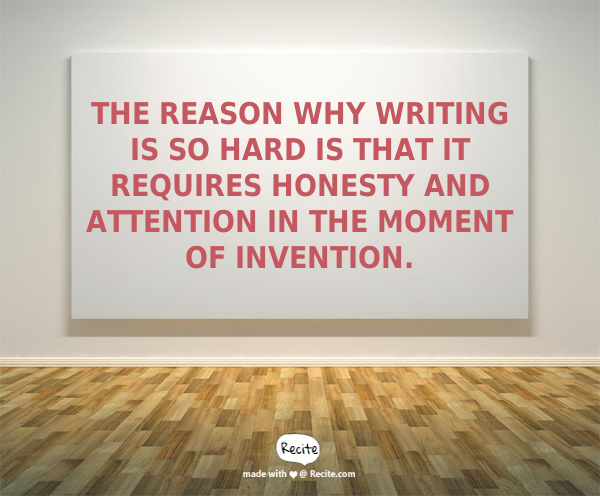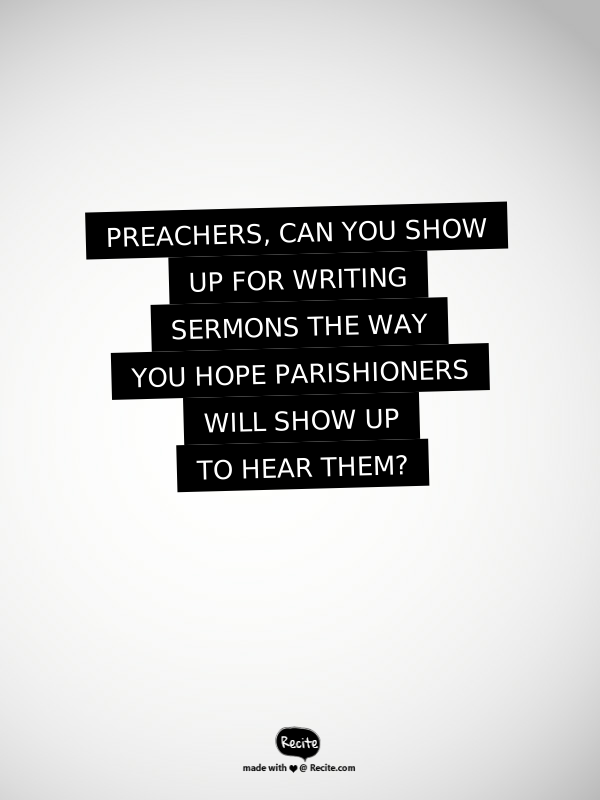News flash: preaching involves writing.
I study writing, and I have studied the writing that preachers do, and I am here to tell you: writing is a huge part of preaching. And writing is really, really difficult.
The most difficult thing about writing isn’t always anything in the writing, it’s actually just doing the writing at all. Forcing yourself to do it. If you don’t believe me, go visit any dissertating doctoral student’s apartment and witness the piles of clean laundry, the baking, and the art projects. Anything other than writing. Or, for a certain group of pastors, visit on Friday morning and see a house that’s been cleaned, an office that’s been organized, a well-weeded garden— and an open laptop somewhere with Facebook open instead of a sermon.
Most books about preaching focus more on the content of sermons than on how they’re made. Three-point, law-and-gospel, topical– ok, but how to get from the empty page to one of those? What writing processes? What practices— not just reading practices, but writing practices– lead you there?
Which is why someone might pick up a book like 8 Hours or Less: Writing Better Sermons Faster by Ryan Huguley (Moody, coming out in May 2017). It’s a prescription about workflow: do this on Monday, do this on Tuesday. If you like direction, you’ll understand why this book could be attractive.
Here’s what Huguley misses, though: the reason why writing is so hard is that it requires honesty and attention in the moment of invention. And that is a moment requiring so much bravery that many of us would rather do anything (even weed a garden!) rather than face it.

Anyone who has ever written has felt writing’s difficulty. Sometimes it’s starting at the blank page or screen, not knowing how to begin. Other times it’s sitting stuck in the middle of a sentence or a paragraph, reaching for a word that doesn’t come. Or it’s writing oneself halfway into an argument that suddenly, somewhere in the middle, breaks down. Or it’s sharing writing with a reader and finding, painfully, that you have not made yourself clear, or—more often—hesitating fearfully before sharing with a reader, or before writing at all, for fear of criticism.
In preaching, it’s hearing in the Gospel story the story of some situation with some parishioner, but not feeling you can speak to that too directly. It’s feeling the week’s text resonate with some aspect of your own life, but feeling (or, in some cases, knowing) that the congregation isn’t ready for that story right now, or that you’re not ready to tell it. Or it’s being tired, so tired, and discouraged, and not feeling the joy in preparing to preach that you used to feel. And it’s feeling guilty about that. None of that is conducive to writing fluently, or well.
Huguley’s book touches none of that. It just gives orders, assigning writing tasks to its reader on a schedule. An eight-hour schedule. Scheduling is really important, but for this advice to be helpful it has to speak to why the reader hasn’t taken the advice already.
So, here are some alternative resources, resources that point to the real difficulty in writing for preaching: this powerful list of Resources on Preaching for Women from the Junia Project, which includes more attention to craft than I’m used to seeing. No easy answers there.
And there’s the set of ideas that comes from seeing yourself as a writer, and then attending to doing the things writers do. Is there one right way? No. These astoundingly interesting portraits of writers’ processes at Brainpickings show how there is not.
But they do show one thing that all writers know and must do. And it is the one thing that all the pastors in my study of writing for preaching must do, too– at least, if they want a day off before Sunday rolls back around, as it inevitably does.
It’s showing up.
Just showing up for the writing. Like you show up for a dentist appointment even though you don’t really “feel in the mood” to have metal pokers jabbing into your teeth. Like you show up to pick up your kids even though you were in the middle of something when it was time to go. You have to show up. We can talk all day long about what to do once you’ve started writing, but the real truth is that most of us are saying we have writing problems when our real problem is that we didn’t even show up. Didn’t sit at the desk, didn’t open the document, didn’t start typing.
 Preachers, can you show up for writing sermons the way you hope parishioners will show up to hear them? You hope they’ll show up on time. You hope they’ll show up even when they’re not really in the mood. You hope they’ll show up even if they’re tired, and even if their laundry’s not done. You hope they’ll show up with open hearts, with ears that hear and minds that consider. You hope they’ll show up like this because you know that there’s something just for them in the Gospel, no matter how bad your sermon turns out.
Preachers, can you show up for writing sermons the way you hope parishioners will show up to hear them? You hope they’ll show up on time. You hope they’ll show up even when they’re not really in the mood. You hope they’ll show up even if they’re tired, and even if their laundry’s not done. You hope they’ll show up with open hearts, with ears that hear and minds that consider. You hope they’ll show up like this because you know that there’s something just for them in the Gospel, no matter how bad your sermon turns out.
Can you show up for your preaching in the same way? Come on time, be awake, ignore the laundry, forget whether you’re in the mood. Just show up and start writing. There is something in the Gospel for you. If you show up.

